Sourdough English Muffins
This post may contain affiliate links. See my disclosure policy.
Learn how to make your own sourdough English muffins! The perfect combination of crusty and chewy, there really is no comparison in flavor and texture to these naturally leavened English muffins. And they’re easy to make!
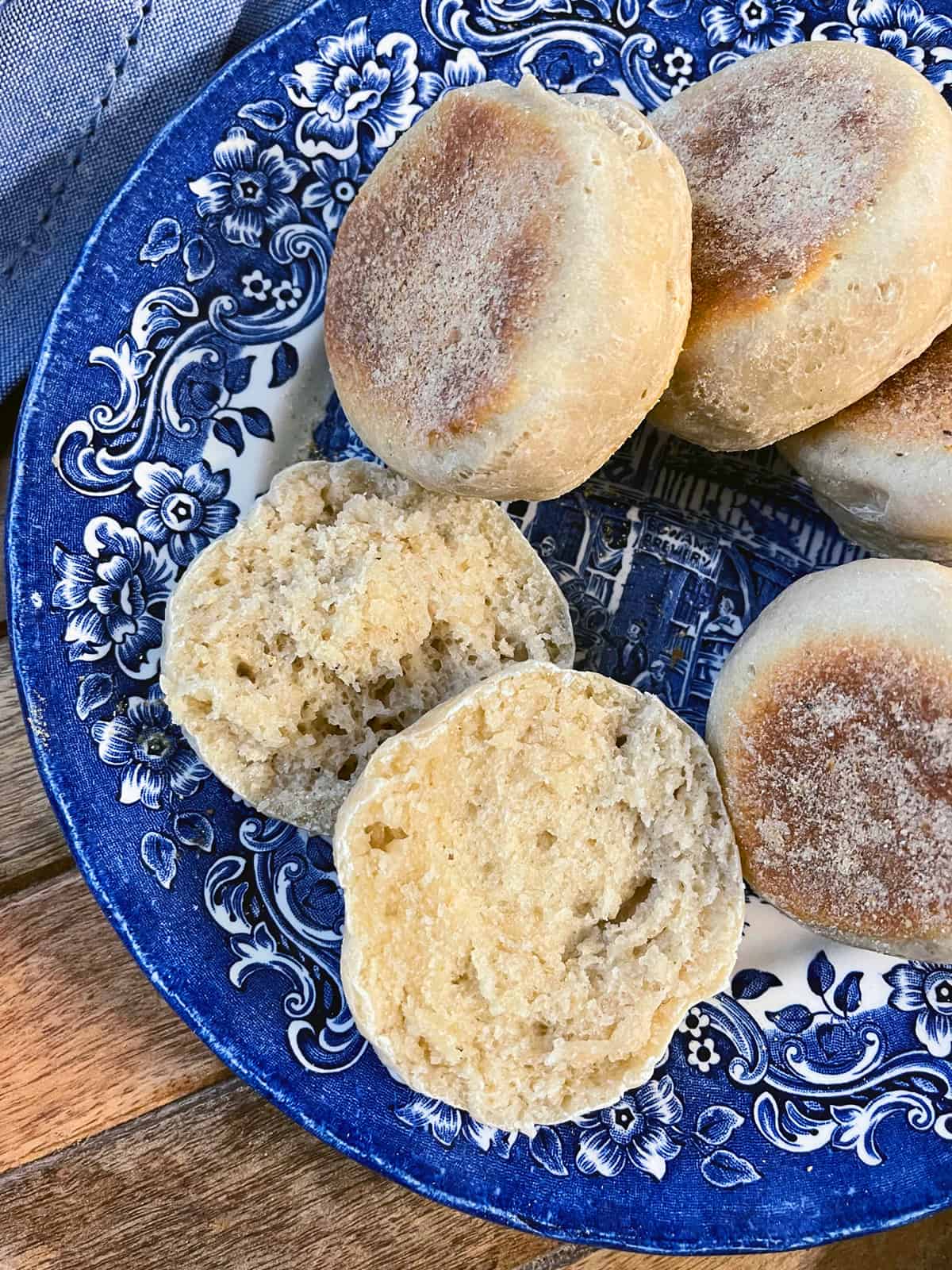
Contrary to their name, English muffins were actually invented in the United States, albeit by an English immigrant. In 1880, Samuel Bath Thomas opened up a bakery in the Chelsea neighborhood of New York City and started making a variation of traditional English crumpets. They became so popular and in demand that he opened up a second bakery and eventually trademarked his “English muffins” in 1926. They’ve remained a staple in American cuisine and are found in every grocery store and are commonly served in restaurants across the nation, either toasted with butter and jam or as the crispy foundation for Eggs Benedict. It wasn’t until the 1990’s that the U.S. began importing them to Great Britain where they are known not as “English” muffins, but rather “American muffins”, “toasting muffins” and “breakfast muffins.”
How to Make Sourdough English Muffins
Sourdough English muffins are made the same way as regular ones but instead of using commercial yeast they use sourdough starter, a wild form of yeast. Because they rely on this wild form of yeast they take longer to rise and undergo a fermentation process that comes with several advantages over English muffins made with commercial yeast:
- The natural fermentation process creates a more complex, superior flavor.
- It also produces a superior texture with a soft and chewy interior and crispy exterior.
- The sourdough acts as a prebiotic and as the dough ferments the gluten is broken down making it easier to digest and gives it a lower glycemic index.
- The slow fermentation process of sourdough increases the bioavailability of the bread’s vitamins and minerals, making it more nutritious.
- Sourdough typically keeps longer then regular bread, making it better for storage.
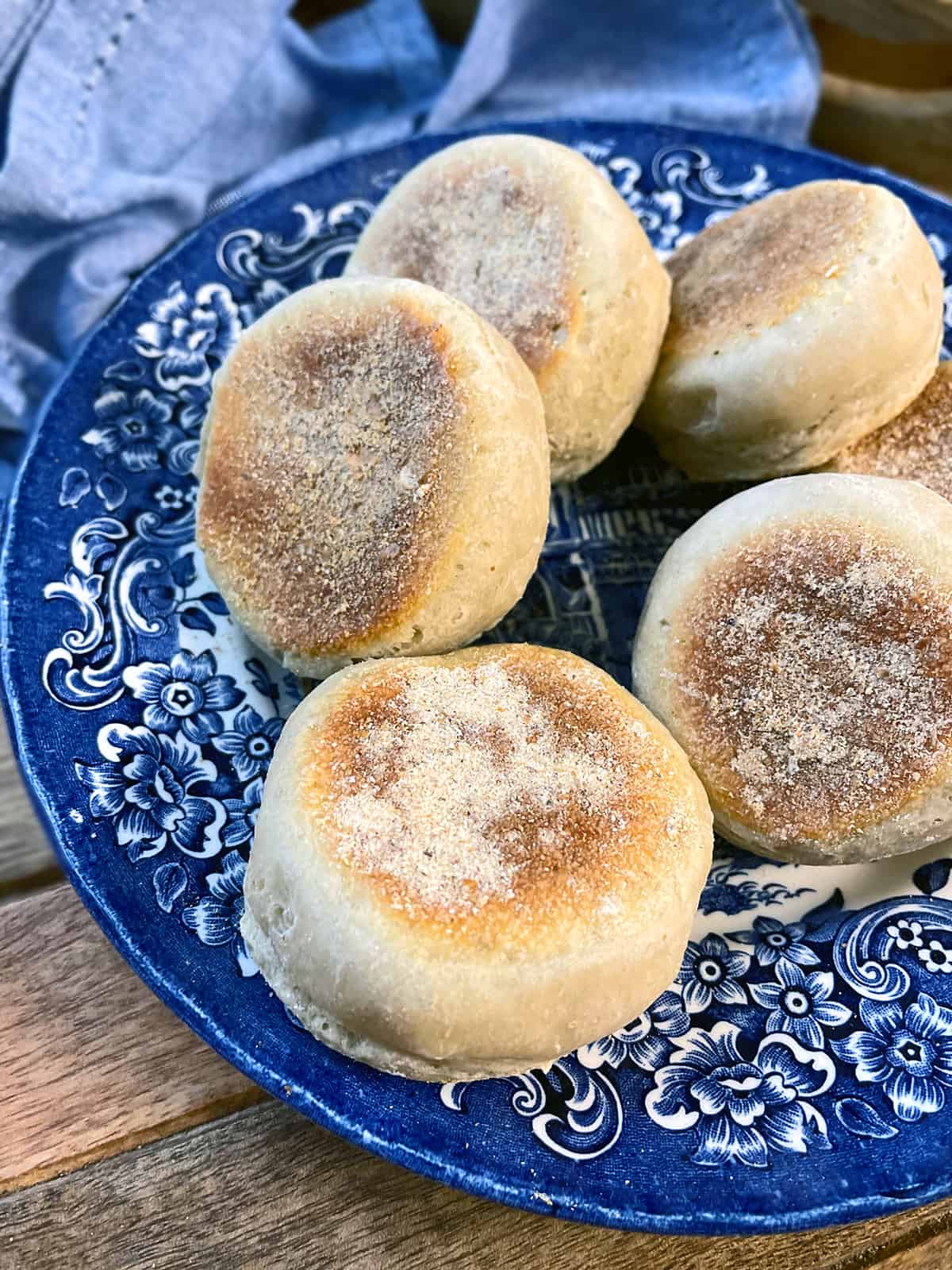
Short vs. Long Ferment
You can ferment your sourdough for anywhere from overnight to up to 24 hours. You can ferment it longer, up to 48 hours, but the longer it ferments the more the gluten structure will break down and the texture will be denser. If you have gluten sensitivities you can let it ferment even longer, up to 72 hours, but again, the gluten will lose structure the crumb will be dense and chewy. We have gluten sensitivities in our family that show up in the form of bloating and water retention and I have been finding that the longer the ferment the fewer the symptoms. The longer the sourdough ferments the more the gluten is broken down and thus easier to digest. I do prefer the flavor and texture of a shorter fermentation time, but for us the tradeoff is worth it. For reference, the photos throughout this post feature a 3-day ferment which results in a denser crumb.
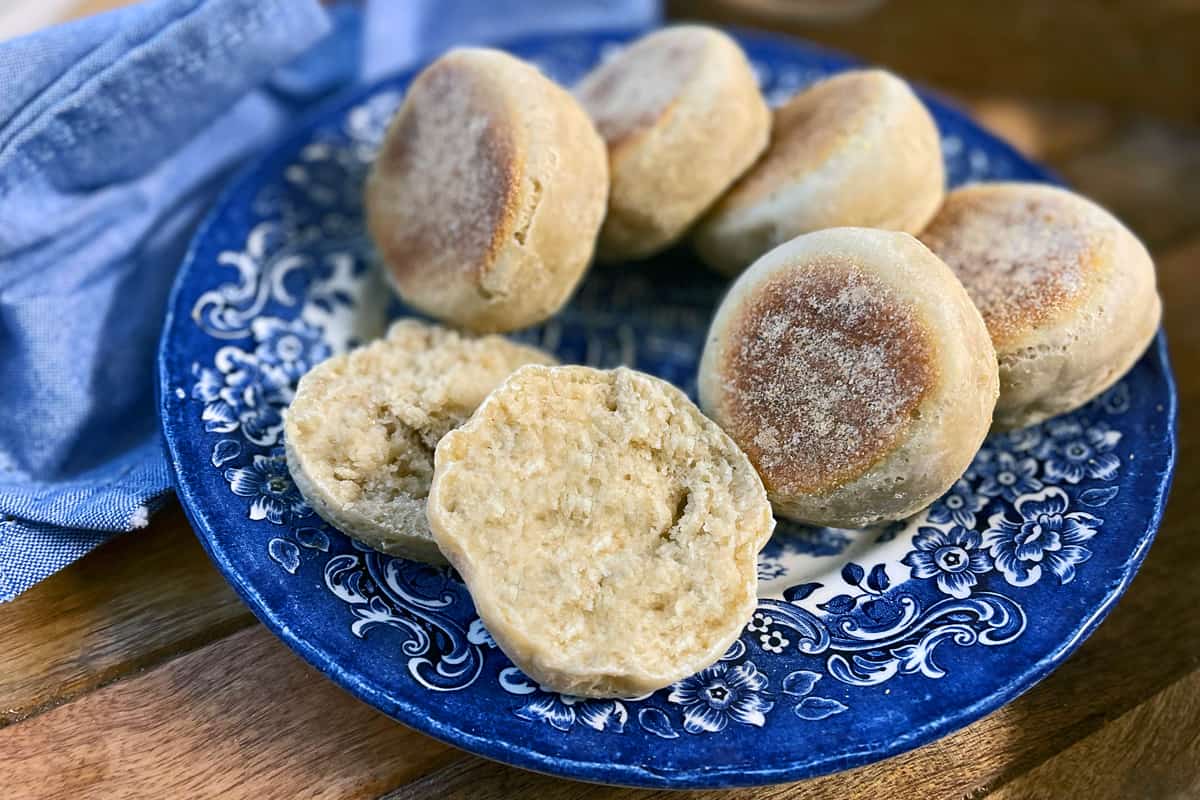
Pro Tips
These sourdough English muffins are easy to make but as with many things, it may take some practice to get a “feel” for how the texture of the dough should be and how long it should rise. Here are a few things to keep in mind:
- The ambient humidity and temperature of your kitchen will impact the texture and rise. If the dough seems too stiff, add a little more milk or water. If it’s too runny, add a little more flour. If the dough too stiff the muffins will be dense and stodgy. If the dough is too wet the muffins will turn out flat.
- The fermentation time will vary depending on the ambient temperature. The warmer your kitchen is, the faster the rise. The cooler the temperature is, the slower the rise.
- While you can make the English muffins after the bulk fermentation (the first rise), letting the dough ferment in the fridge for an additional day will greatly increase the quality of the flavor and texture.
- Make sure the griddle or cast iron skillet have fully heated before adding the muffins. If the bottoms appear to be browning too fast, turn down the heat accordingly.
- Use an instant read thermometer to determine when the sourdough English muffins are done. No guesswork needed.
- If the muffins have browned too quickly on the outside and are not yet cooked inside, you can place them in the oven at 300 F to finish cooking.
Can You Freeze Sourdough English Muffins?
Yes, these freeze well! Wrap them tightly and place them in a freezer ziplock bag, or in a freezer-safe container. They can be frozen for up to 3 months. Let them thaw, slice, and toast them.
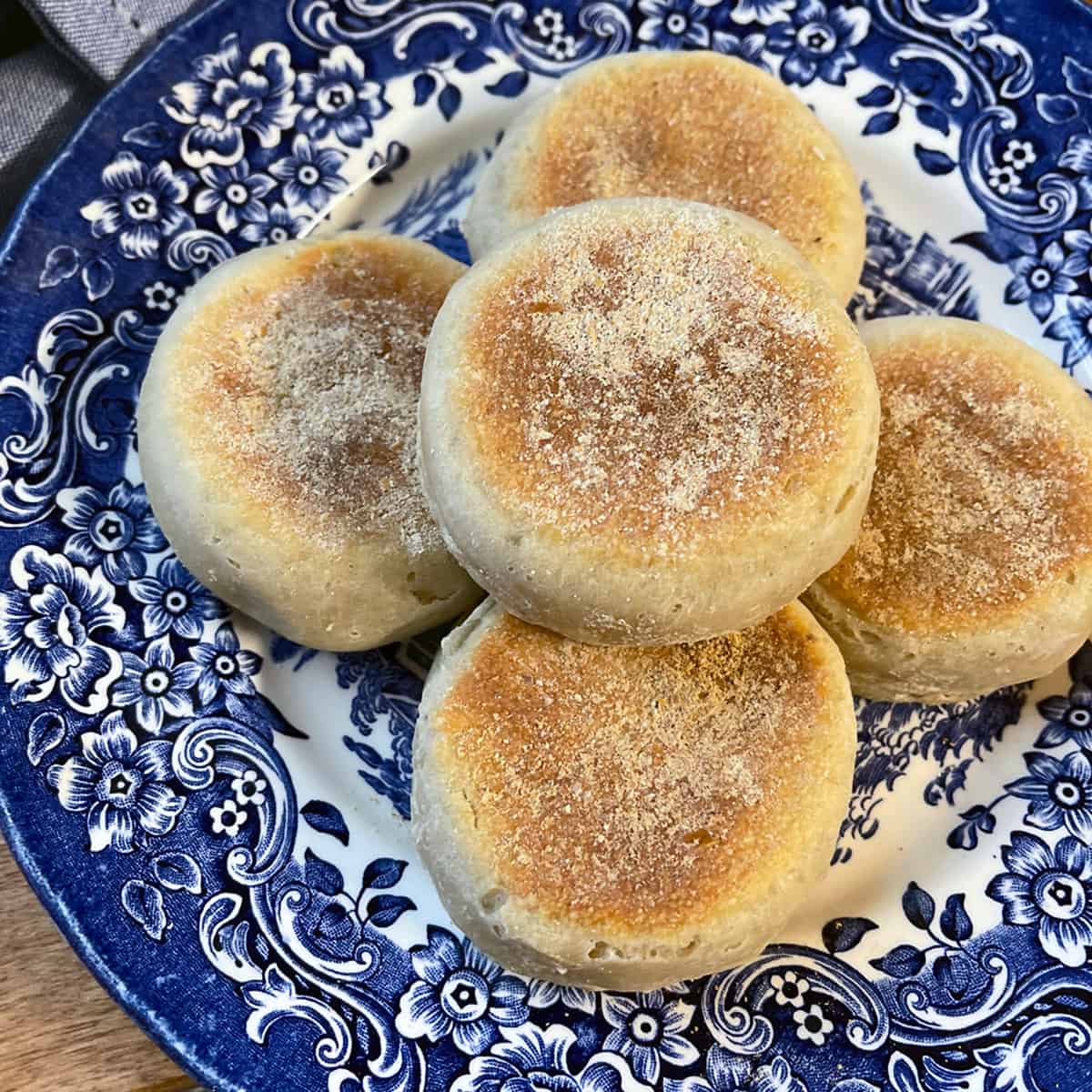
Sourdough English Muffins Recipe
Let’s get started!
In the bowl of your stand mixer fitted with the dough hook, add the flour, salt, sourdough starter, milk, water, honey or sugar, and melted butter. Knead the dough on 2 for 6-8 minutes until a smooth dough has formed (note, you can also knead it by hand). It should be soft and not too stiff, but not overly wet. Form the dough into a ball, lightly spray the bowl with oil, place the dough ball in it and cover with plastic wrap. Let it sit at room temperature for 8-10 hours (over overnight) to bulk ferment or until it has doubled in size.
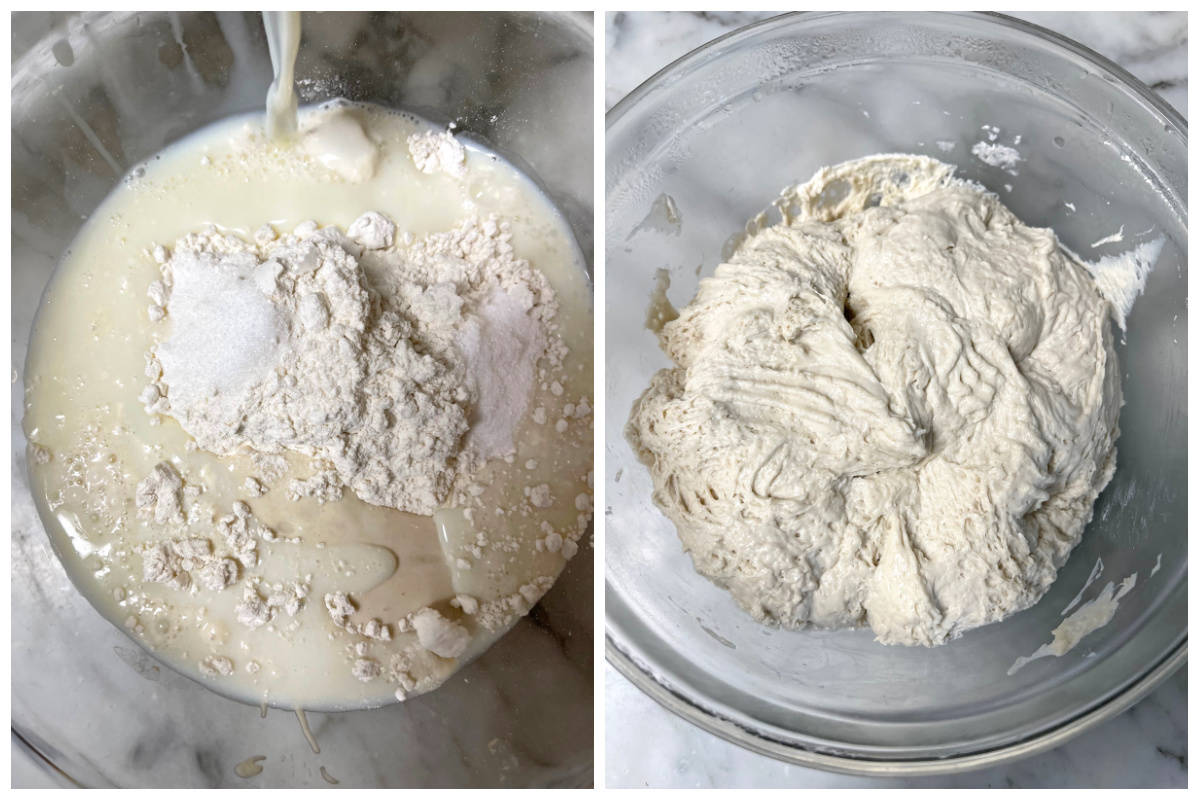
You now have two options: 1) Proceed with the recipe to make English muffins, or 2) let the dough continue to ferment in the refrigerator for a more complex flavor. If fermenting it longer, punch down the dough, form it into a ball, place it back in the bowl, cover with plastic wrap and refrigerate for up to another 36 hours (see blog post above about extending the ferment).
Turn the dough out onto a lightly floured surface or parchment paper very light sprayed with oil. Gently press the dough into an oval or circle with a 1/2 inch thickness (any thicker and you risk the muffins not fully cooking through).
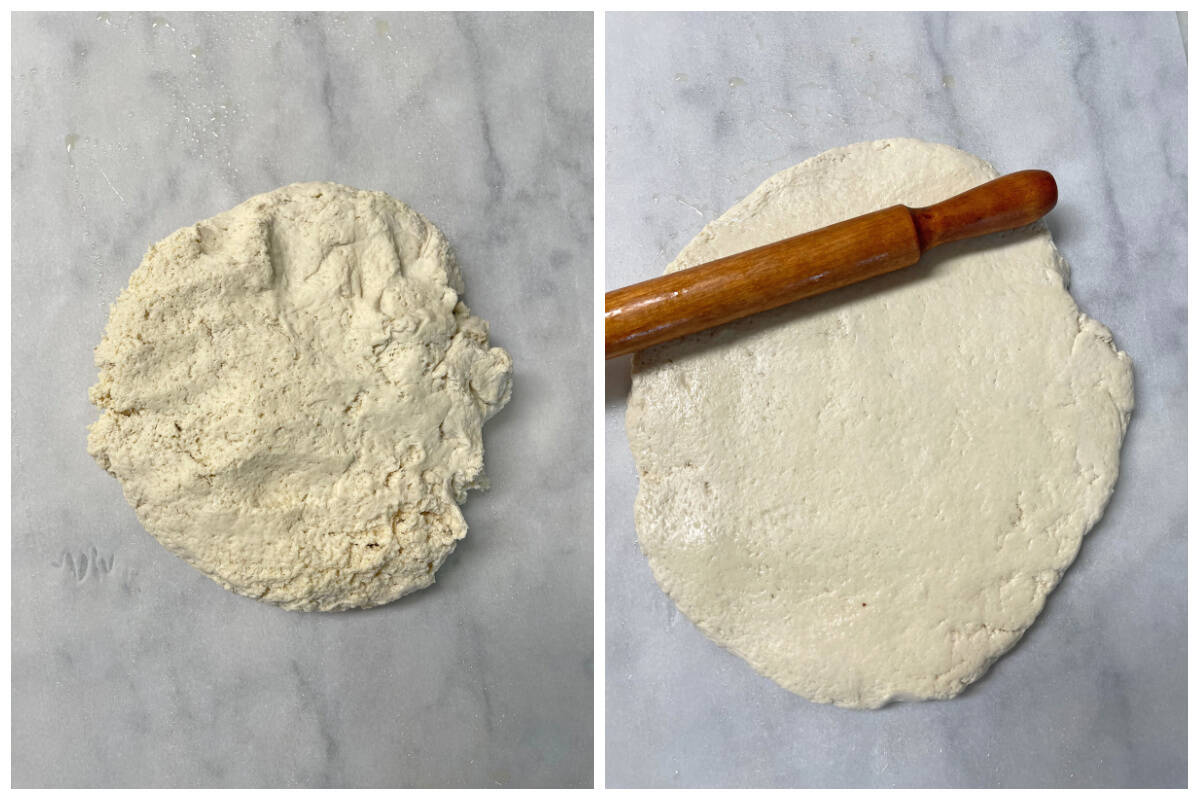
Use a 3 inch biscuit cutter to cut the dough into circles and then transfer them to a lined baking sheet dusted with cornmeal.
Cover the rounds loosely with plastic wrap and let them rise at room temperature for about another hour or until puffy (they will not rise much). Note: If you chilled your dough in the refrigerator, this will take 2 or more hours (no need to bring the dough ball to room temp first, simply proceed with cutting into rounds and then let them rise longer).
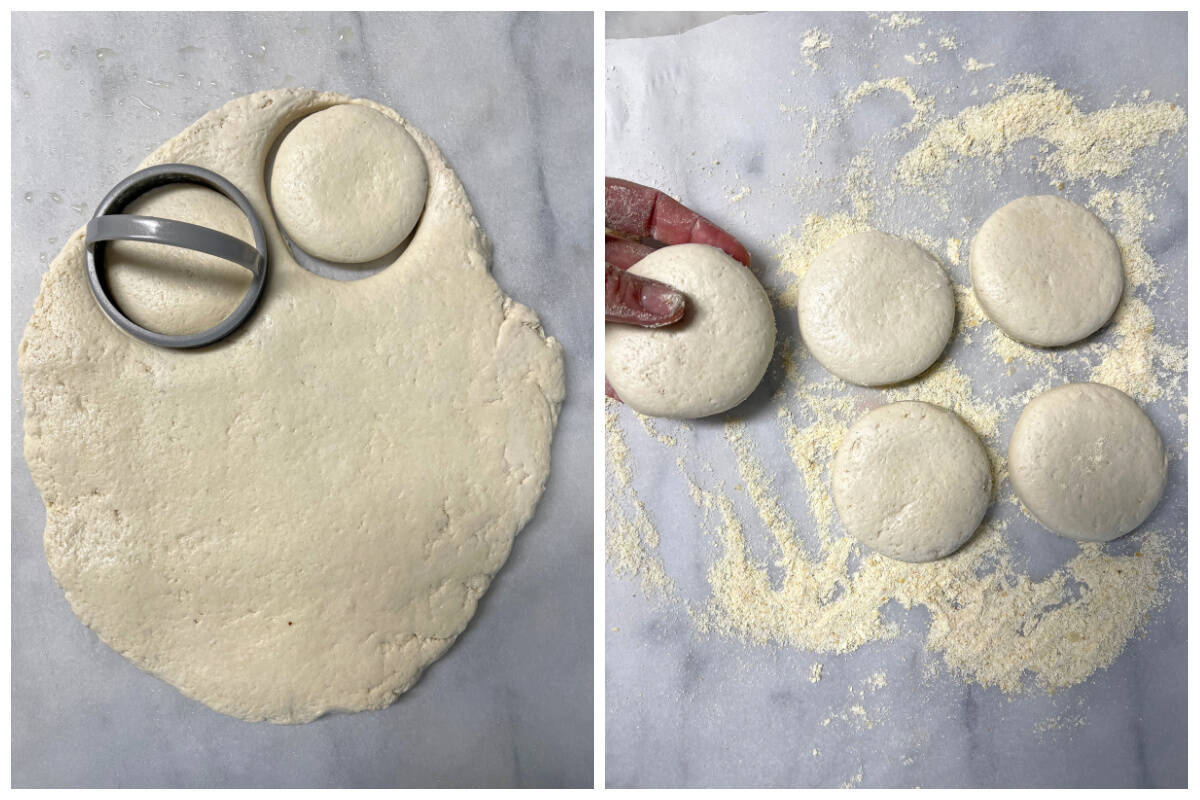
Preheat a griddle or cast iron skillet to about 325 degrees F. Do not grease.
I’m using my absolute favorite Waring Commercial 16″ Electric Crepe Maker to cook these English muffins. With a cast iron cooking surface and stainless steel base, this thing is built like a tank and performs like a pro. It’s pricey but it’s my workhorse and I use it for everything from crepes, pancakes, and flatbread like my Lavash, Injera and Sourdough Naan.
Place the rounds cornmeal side down onto the un-greased griddle or cast iron skillet at least an inch apart. The muffins will rise as they cook. Let them cook undisturbed for 8-10 minutes, then gently flip them over to cook on the other side for another 8-10 minutes.
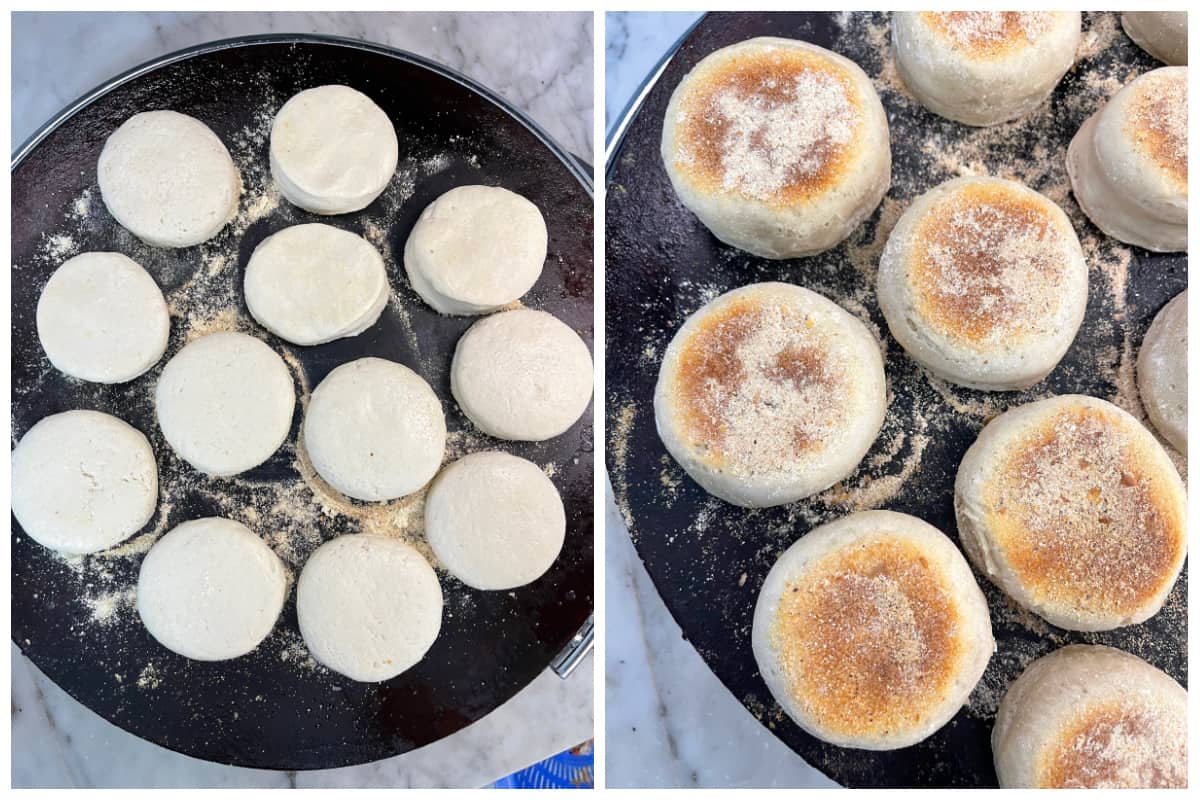
They should be a nicely browned on both sides and they are done when the internal temperature reads 200-205 F. I strongly recommend using an instant read thermometer; it removes all the guesswork. If the muffins have browned too quickly on the outside and are not yet cooked inside, you can place them in the oven at 300 F to finish cooking.
Remove the muffins from the griddle, and cool on a rack.
To store, wrap them tightly or place them in an airtight container where they will at room temperature for 4-5 days. They can also be frozen for up to 2 months, then thawed, sliced and toasted.
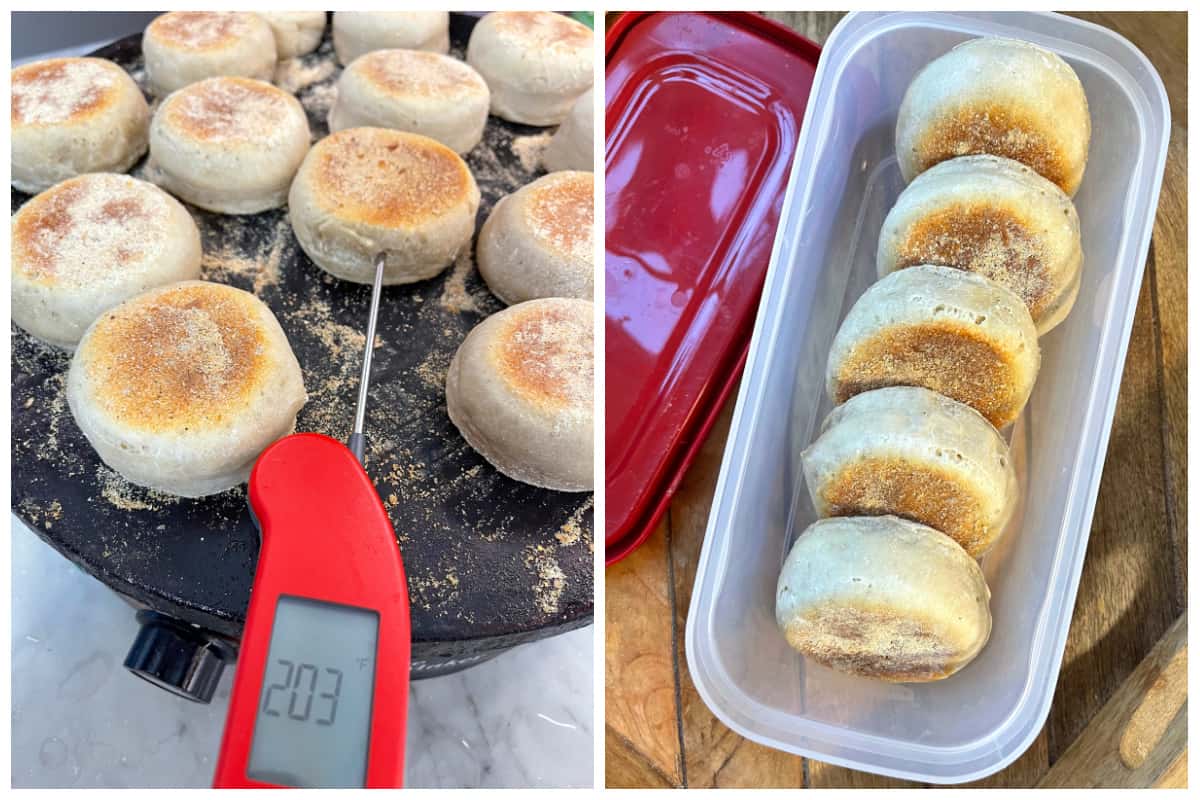
Serving Suggestions
To serve, slice them open and serve with butter and jam or honey, cold cuts and cheese, make Egg McMuffins, or Eggs Benedict with out homemade Hollandaise Sauce! For some yummy homemade jam options try our Strawberry Rhubarb Jam, Plum Jam, Blackberry Jam, Gooseberry Jam, Black Currant Jam, Red Currant Jelly, Plum Butter, Apple Butter!
For a lovely crispy texture, slice and toast them before serving. To get those characteristic nooks and crannies use a fork to cut the English muffins open: stick a fork into the sides of the muffins and pull them apart with your fingers.
Enjoy!
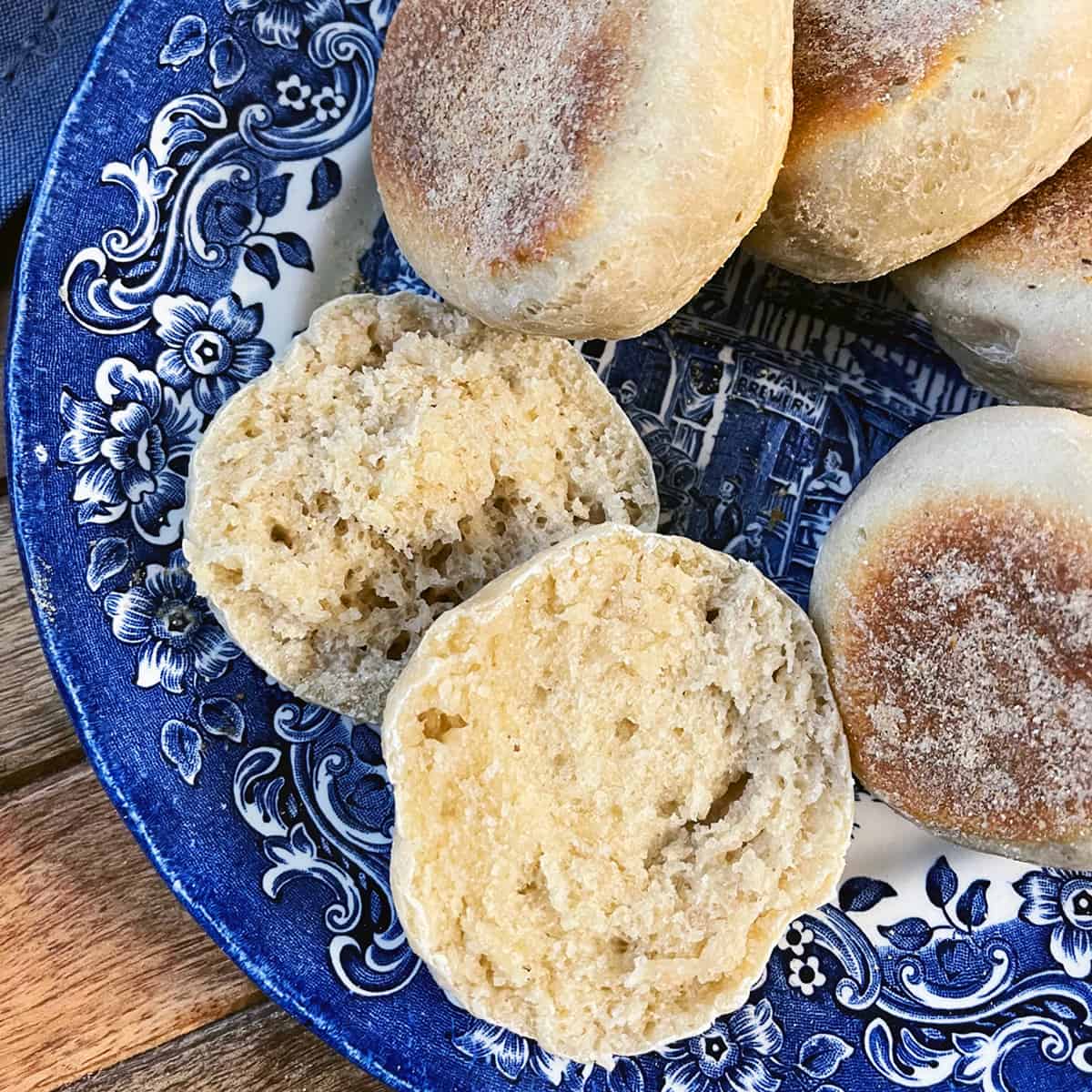
More sourdough favorites be sure to also try my:
Save This Recipe
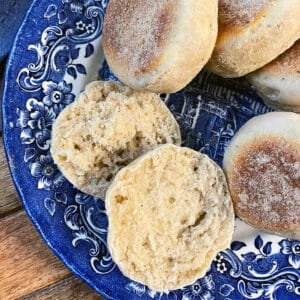
Sourdough English Muffins
Ingredients
- 3 cups all-purpose flour
- 3/4 cup milk
- 1/2 cup water
- 1/2 cup fed/active sourdough starter
- 2 teaspoons honey or sugar (optional)
- 1 1/4 teaspoons salt
- 1 tablespoon butter , melted but not hot
Instructions
- In the bowl of your stand mixer fitted with the dough hook, add the flour, salt, sourdough starter, milk, water, honey or sugar, and melted butter. Knead the dough on 2 for 6-8 minutes until a smooth dough has formed (note, you can also knead it by hand). It should be soft and not too stiff, but not overly wet (if there isn't enough flour the muffins will turn out flat). Form the dough into a ball, lightly spray the bowl with oil, place the dough ball in it and cover with plastic wrap. Let it sit at room temperature for 8-10 hours (over overnight) to bulk ferment or until it has doubled in size. You now have two options: 1) Proceed with the recipe to make English muffins, or 2) let the dough continue to ferment in the refrigerator for a more complex flavor. If fermenting it longer, punch down the dough, form it into a ball, place it back in the bowl, cover with plastic wrap and refrigerate for up to another 36 hours (see blog post about going longer).
- Turn the dough out onto a lightly floured surface. Gently press it into an oval or circle with a 1/2 inch thickness (any thicker and you risk the muffins not fully cooking through). Use a 3 inch biscuit cutter to cut the dough into circles and then transfer them to a lined baking sheet dusted with cornmeal. Cover the rounds loosely with plastic wrap and let them rise at room temperature for about another hour or until puffy (they will not rise much). If you chilled your dough in the refrigerator, this will take 2 or more hours (no need to bring the dough ball to room temp first, simply proceed with cutting into rounds and then let them rise longer).
- Preheat a griddle or cast iron skillet to about 325 degrees F. Do not grease.Place the rounds cornmeal side down onto the un-greased griddle or cast iron skillet at least an inch apart. The muffins will rise as they cook. Let them cook undisturbed for 8-10 minutes, then gently flip them over to cook on the other side for another 8-10 minutes. They should be a nicely browned on both sides and they are done when the internal temperature reads 200-205 F. I strongly recommend using an instant read thermometer; it removes all the guesswork. Remove the muffins from the griddle, and cool on a rack. Slice them open and enjoy. For a lovely crispy texture, slice and toast them. To get those characteristic nooks and crannies use a fork to cut the English muffins open: stick a fork into the sides of the muffins and pull them apart with your fingers. To store, wrap them tightly or place them in an airtight container where they will at room temperature for 4-5 days. They can also be frozen for up to 3 months, then thawed, sliced and toasted.
Nutrition



















I found your website after my wife and I were wondering about the difference between crumpets and english muffins. We’re going to try the crumpet recipe after we pick up some rings. I would like to try your english muffin recipe but rather using yeast instead of sourdough. Do you have a recipe variation for yeast?
I’m so glad you found my site, Mike, welcome! I don’t currently have a variation using yeast but there are some great options online. I hope you enjoy the crumpets, please let us know how it goes!
This was my first time ever attempting to make English muffins. When I saw that you had a sourdough version I knew I had to try. I went for a 24 hour ferment. Your pictures were very helpful and I am so proud to say that mine were a success! Beautiful texture and lovely flavor. My husband and kids were impressed that I made homemade English muffins and everyone loved them!
Thank you so much, Tammy, I’m absolutely thrilled that you and your family enjoyed them!